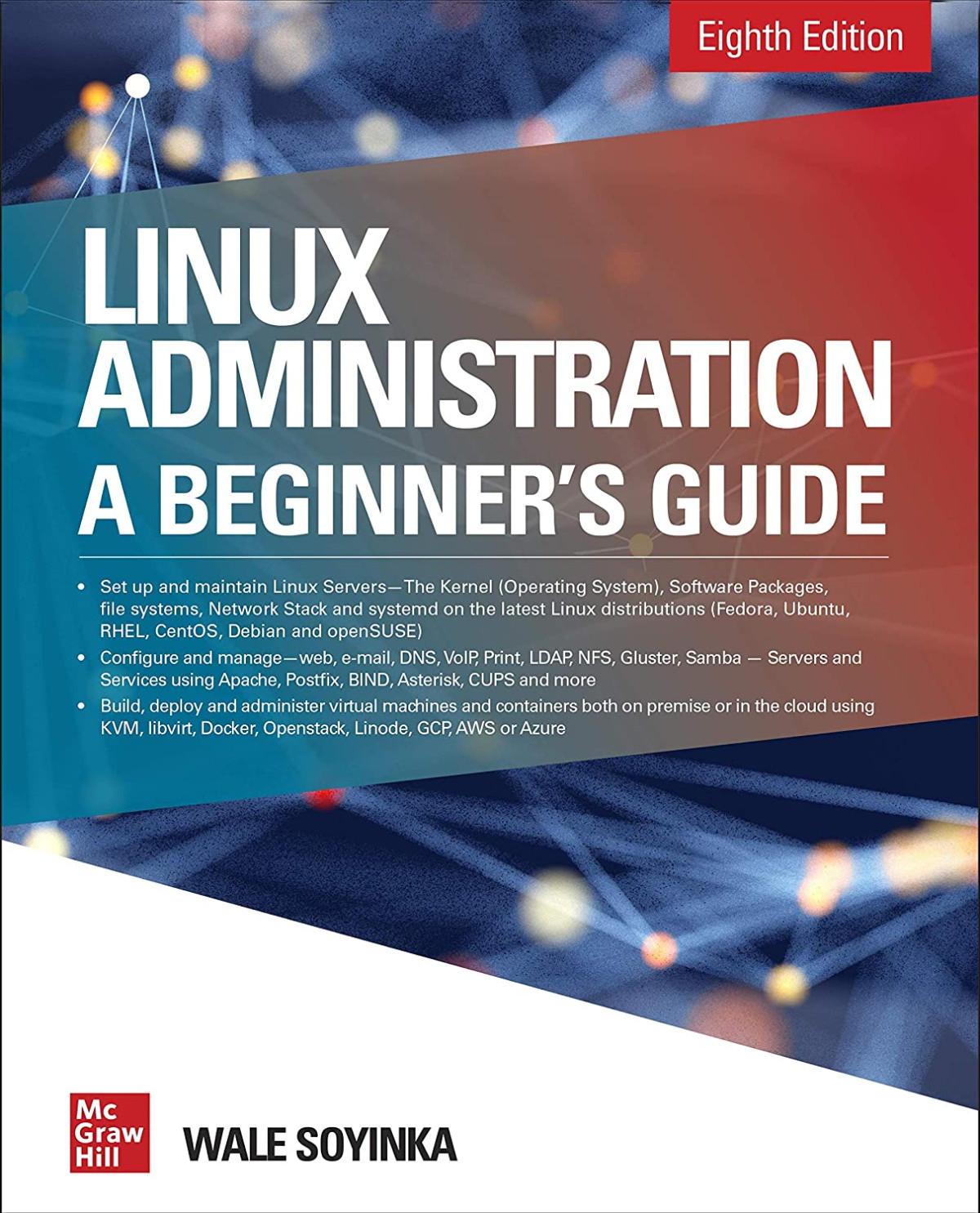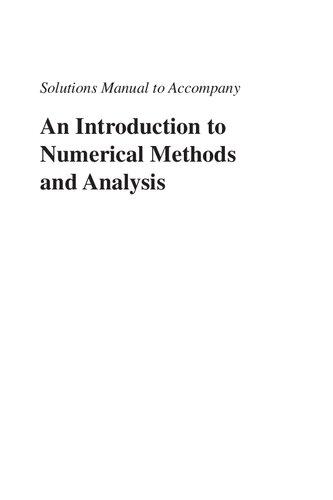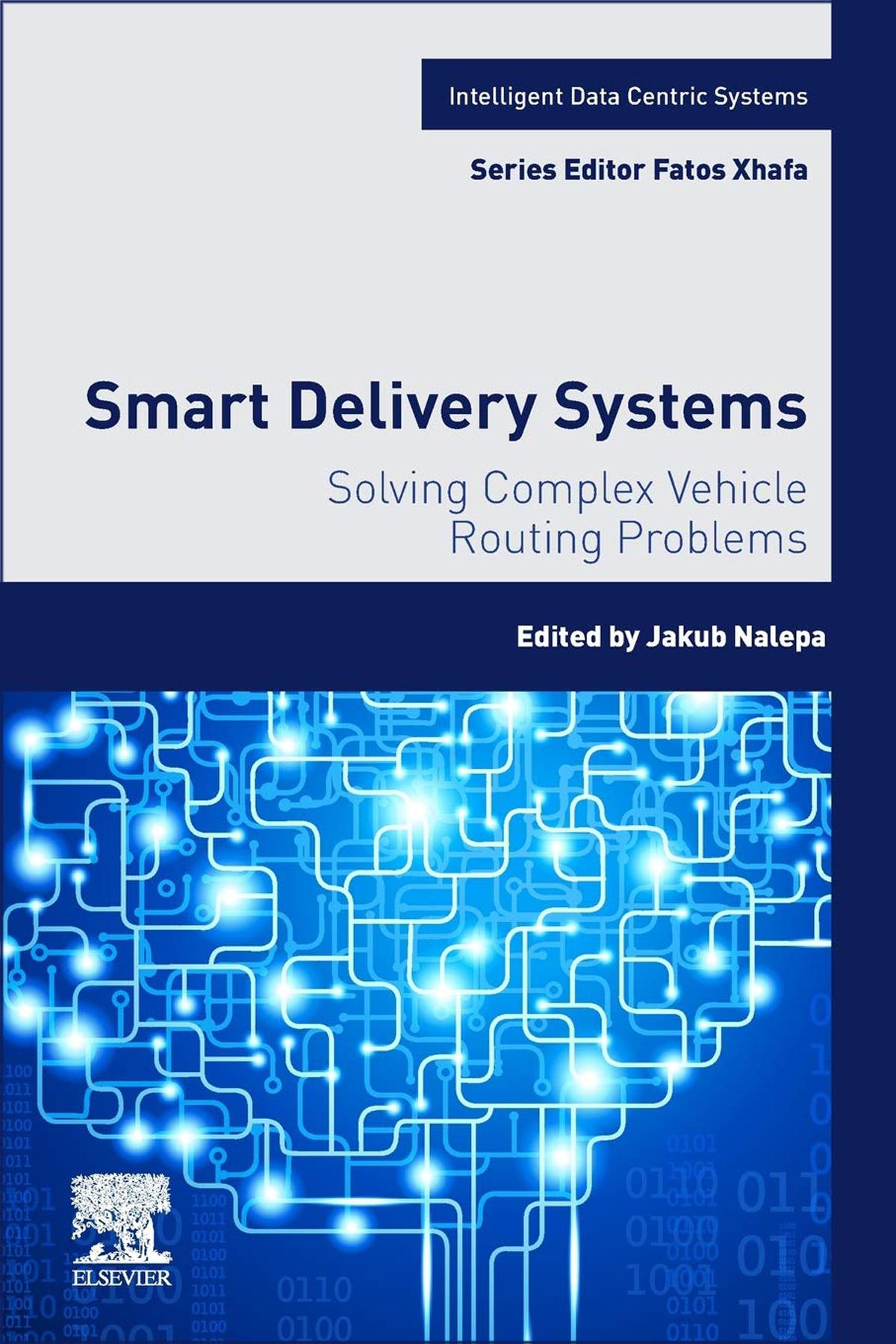SmartDeliverySystems SolvingComplexVehicleRoutingProblems
Editedby JakubNalepa
Elsevier
Radarweg29,POBox211,1000AEAmsterdam,Netherlands
TheBoulevard,LangfordLane,Kidlington,OxfordOX51GB,UnitedKingdom 50HampshireStreet,5thFloor,Cambridge,MA02139,UnitedStates
Copyright©2020ElsevierInc.Allrightsreserved.
Nopartofthispublicationmaybereproducedortransmittedinanyformorbyanymeans, electronicormechanical,includingphotocopying,recording,oranyinformationstorageand retrievalsystem,withoutpermissioninwritingfromthepublisher.Detailsonhowtoseek permission,furtherinformationaboutthePublisher’spermissionspoliciesandourarrangements withorganizationssuchastheCopyrightClearanceCenterandtheCopyrightLicensingAgency, canbefoundatourwebsite: www.elsevier.com/permissions.
Thisbookandtheindividualcontributionscontainedinitareprotectedundercopyrightbythe Publisher(otherthanasmaybenotedherein).
Notices
Knowledgeandbestpracticeinthisfieldareconstantlychanging.Asnewresearchand experiencebroadenourunderstanding,changesinresearchmethods,professionalpractices,or medicaltreatmentmaybecomenecessary.
Practitionersandresearchersmustalwaysrelyontheirownexperienceandknowledgein evaluatingandusinganyinformation,methods,compounds,orexperimentsdescribedherein.In usingsuchinformationormethodstheyshouldbemindfuloftheirownsafetyandthesafetyof others,includingpartiesforwhomtheyhaveaprofessionalresponsibility.
Tothefullestextentofthelaw,neitherthePublishernortheauthors,contributors,oreditors, assumeanyliabilityforanyinjuryand/ordamagetopersonsorpropertyasamatterofproducts liability,negligenceorotherwise,orfromanyuseoroperationofanymethods,products, instructions,orideascontainedinthematerialherein.
LibraryofCongressCataloging-in-PublicationData
AcatalogrecordforthisbookisavailablefromtheLibraryofCongress
BritishLibraryCataloguing-in-PublicationData
AcataloguerecordforthisbookisavailablefromtheBritishLibrary
ISBN:978-0-12-815715-2
ForinformationonallElsevierpublications visitourwebsiteat https://www.elsevier.com/books-and-journals
Publisher: JoeHayton
AcquisitionEditor: BrianRomer
EditorialProjectManager: ReddingMorse
ProductionProjectManager: Bharatwaj Varatharajan
Designer: AlanStudholme
TypesetbyVTeX
ThisbookisinmemoryofDr.GrzegorzNalepa,an extraordinaryscientistandpediatrichematologist/oncologist atRileyHospitalforChildren,Indianapolis,USA,whohelped countlesspatientsandtheirfamiliesthroughsomeofthemost challengingmomentsoftheirlives.
1.Currentandemergingformulationsandmodelsof real-liferichvehicleroutingproblems
JacekWiduch
1.1Introduction 1
1.2VehicleRoutingProblemanditsvariants 2
1.2.1TheclassicalVehicleRoutingProblem2
1.2.2VariantsoftheVRP3
1.2.3GreenVehicleRoutingProblem(GVRP)6
1.2.4ElectricVehicleRoutingProblem(EVRP)7
1.2.5AlgorithmsforsolvingtheVRPanditsvariants10
1.3BusRoutingProblemanditsvariants 11
1.3.1BicriterionBusRoutingProblem(BBRP)11
1.3.2MulticriteriaBusRoutingProblem(MBRP)14
1.3.3SchoolBusRoutingProblem(SBRP)14
1.3.4OtherselectedvariantsoftheBusRoutingProblem19
1.4UnmannedVehicleRoutingProblem
1.5Theotherroutingproblemsofelectricvehicles
2.Onaroadtooptimalfleetroutingalgorithms:agentle introductiontothestate-of-the-art
PawełGora,DominikaBankiewicz,KatarzynaKarnas, WojciechKa´zmierczak,MichałKutwin,PrzemysławPerkowski, SzymonPłotka,AnnaSzczurek,andDamianZi˛eba
2.1Introduction
2.2OptimalRouteChoiceproblem
2.2.1Introduction38
2.2.2Discretechoicemodels38 2.2.3ShortestPathproblem40
2.2.4TrafficAssignmentproblem41
2.3TravelingSalesmanProblem 46
2.3.1Introduction46
2.3.2TSPanditsgeneralizations46
2.3.3Exactmethods48
2.3.4Approximatesolutions51
2.3.5Quantumalgorithms57
2.3.6Computationalcomplexity58
2.4VehicleRoutingProblem 59
2.4.1Introduction59
2.4.2Taxonomy60
2.4.3CapacitatedVehicleRoutingProblem63
2.4.4VehicleRoutingProblemwithtimewindows70
3.Exactalgorithmsforsolvingrichvehiclerouting problems
MiroslawBlocho
3.1Branch-and-boundmethods
3.3Branch-and-pricemethods
3.4Branch-and-cut-and-pricemethods
4.Heuristics,metaheuristics,andhyperheuristicsforrich vehicleroutingproblems
MiroslawBlocho
4.1Heuristicsforrichvehicleroutingproblems 101
4.1.1Constructionheuristics101 4.1.2Improvementheuristics103
4.2Metaheuristicsforrichvehicleroutingproblems 106
4.2.1SimulatedAnnealing107
4.2.2TabuSearch108
4.2.3AdaptiveMemoryProcedures110
4.2.4VariableNeighborhoodSearch112
4.2.5LargeNeighborhoodSearch113
4.2.6GreedyRandomizedAdaptiveSearchProcedure114
4.2.7ParticleSwarmOptimization115
4.2.8AntColonyAlgorithms117
4.2.9ArtificialBeeColonyAlgorithms120
4.2.10BatAlgorithms122
4.2.11Cuckoosearch123
4.2.12FireflyAlgorithms125
4.2.13GoldenBallAlgorithms126
4.2.14GravitationalSearchAlgorithm127
4.2.15BacterialForagingOptimizationAlgorithm128
4.2.16GeneticandEvolutionaryAlgorithms129
4.2.17MemeticAlgorithms137
4.3Hyperheuristicsforrichvehicleroutingproblems
5.Hybridalgorithmsforrichvehicleroutingproblems: asurvey
RajeevKr.GoelandSandhyaRaniBansal
5.1Introduction 157
5.1.1Methodologyandcontributionofthischapter158
5.1.2Structureofthechapter158
5.2MathematicalmodelfortraditionalCVRP 159
5.2.1Objectivefunction159
5.2.2Problemconstraints159
5.2.3Flowconstraint159
5.2.4Capacityconstraint160
5.2.5ThemathematicalmodelofclassicalVRP160
5.3FromtraditionalVRPtorichVRP 160
5.3.1TraditionalVRP160
5.3.2TraditionaladvancedVRP161
5.3.3RichVRP&real-lifeVRP161
5.3.4RichVRPdefinition161
5.4SolutionapproachesforRVRPs 162
5.5LiteraturereviewofhybridapproachesforVRPs 164
5.5.1Real-lifeVRP(distributionsystem)164
5.5.2RichVRP168
5.6Conclusionandfuturedirections
6.Parallelalgorithmsforsolvingrichvehiclerouting problems
MiroslawBlocho
6.1Parallelismideasandtaxonomies
6.3Paralleltabusearch
6.4Parallelgeneticandevolutionaryalgorithms
6.5Parallelmemeticalgorithms 192
6.6Parallelantcolonyalgorithms 195
6.7Parallelsimulatedannealing
6.8Summary
7.Wheremachinelearningmeetssmartdeliverysystems JakubNalepa
7.1Introduction
7.1.1Agentleintroductiontomachinelearning203
7.1.2Wheremachinelearningmeetssmartdeliverysystems–anoverview209
7.1.3Structureofthischapter210
7.2Tuninghyper-parametersofexistentalgorithmsforsolvingrich vehicleroutingproblemsusingmachinelearning 210
7.3Solvingrichvehicleroutingproblemsusinghybridalgorithms thatexploitmachinelearning
7.4Solvingrichvehicleroutingproblemsusingdata-driven machinelearningalgorithms
7.5Summary
8.HowtoassessyourSmartDeliverySystem?
LuisA.A.Meira,PauloS.Martins,MauroMenzori,andGuilherme A.Zeni
8.1Introduction
8.4.1Generatingdeliverypoints234
8.4.2Definingtheweightbetweenapairofdeliveries235
8.4.3Thebenchmarktool236
8.4.4ModelingManhattan(NY)streets238
8.5Real-worldPostVRPbenchmark(RWPostVRPB)
8.6Finalremarksandconclusion
9.Practicalapplicationsofsmartdeliverysystems TomaszJastrzabandAgataBuchcik
9.1Introduction
9.2Literaturereview
9.2.1Routinginemergencies253
9.2.2Richvehicleroutingproblems255
9.3MineevacuationasarichVRP
Contributors
DominikaBankiewicz FacultyofMathematics,InformaticsandMechanics,University ofWarsaw,Warsaw,Poland
MiroslawBlocho ABB,Krakow,Poland
AgataBuchcik DepartmentofMiningMechanizationandRobotisation,Facultyof Mining,SafetyEngineeringandIndustrialAutomation,SilesianUniversityof Technology,Gliwice,Poland
RajeevKr.Goel C.SDeptt.,Govt.College,Naraingarh,India
PawełGora FacultyofMathematics,InformaticsandMechanics,Universityof Warsaw,Warsaw,Poland
TomaszJastrzab InstituteofInformatics,FacultyofAutomaticControl,Electronics andComputerScience,SilesianUniversityofTechnology,Gliwice,Poland
KatarzynaKarnas FacultyofMathematics,InformaticsandMechanics,Universityof Warsaw,Warsaw,Poland
WojciechKa´zmierczak FacultyofMathematics,InformaticsandMechanics, UniversityofWarsaw,Warsaw,Poland
MichałKutwin FacultyofMathematics,InformaticsandMechanics,Universityof Warsaw,Warsaw,Poland
PauloS.Martins SchoolofTechnology(FT),UniversityofCampinas(UNICAMP), Limeira,SP,Brazil
LuisA.A.Meira SchoolofTechnology(FT),UniversityofCampinas(UNICAMP), Limeira,SP,Brazil
MauroMenzori SchoolofTechnology(FT),UniversityofCampinas(UNICAMP), Limeira,SP,Brazil
JakubNalepa SilesianUniversityofTechnology,Gliwice,Poland
PrzemysławPerkowski FacultyofMathematics,InformaticsandMechanics, UniversityofWarsaw,Warsaw,Poland
SzymonPłotka FacultyofMathematics,InformaticsandMechanics,Universityof Warsaw,Warsaw,Poland
SandhyaRaniBansal C.S.E.Deptt.,M.M.DeemedUniversity,Mullana,India
Contributors
AnnaSzczurek FacultyofMathematics,InformaticsandMechanics,Universityof Warsaw,Warsaw,Poland
JacekWiduch InstituteofInformatics,SilesianUniversityofTechnology,Gliwice, Poland
GuilhermeA.Zeni SchoolofTechnology(FT),UniversityofCampinas(UNICAMP), Limeira,SP,Brazil
DamianZi˛eba FacultyofMathematics,InformaticsandMechanics,Universityof Warsaw,Warsaw,Poland
Currentandemerging formulationsandmodelsof real-liferichvehiclerouting problems
JacekWiduch InstituteofInformatics,SilesianUniversityofTechnology,Gliwice,Poland
1.1Introduction
Theclassofvehicleroutingproblemsencompassesdiscreteoptimizationproblemsconcernedwiththedeterminationofroutesforagivenfleetofvehicles accordingtodefinedobjectivesandconstraints.Vehicleroutingproblemsarethe subjectofintensiveresearchformorethan50years.Itistheclassofproblems ofreal-lifeimportance,anditsapplicationsincludelogistics,travel,communications,manufacturing,transportation,distribution,civil,andmilitarysystems, amongothers.Allmentioneddomainshaveadirectimpactonthemoderneconomyandthecostofgoods.Themodelssurveyedinthischapterarebasedon thetransportationnetworkswheretherealobjectivesareconsidered.Inmany casesafewobjectivesareconsideredsimultaneously,andthustheproblemis resolvedastheNP-hardMulticriteriaOptimizationproblem.
Recently,moreandmoreconstraintsarebeingintroducedintovehicleroutingproblems,andnewtypesofvehiclesarebeingconsidered,resultingin severalnewvariantsoftheproblem.Themostvehiclesrunondieselengines, whicharemajorsourcesofGreenhouseGasemissionsandpollution.Therefore, ecologicalaspectsandthereductionofpollutionaretakenintoaccountinvehicleroutingproblems,andvehicleswithalternativeenergysourceareconsidered asameanoftransport.Theroutingproblemfortheelectricvehiclesandhybrid electricvehiclesisstudied,andproblemsrelatedtousingthistypeofvehicleare analyzed.Anunmannedvehicleisthenextnewtypeofvehicle.Overthepast fewyearsithasbecomemoreandmorepopular,andtheproblemofdetermining therouteforthistypeofvehiclehasalsobecomethesubjectofresearch.
Inthischapter,wepresentthemostpopularandimportantvehiclerouting problems.Anumberofvariantsofresearchedproblemsbasedonreal-lifecom-
municationandtransportationnetworksareconsideredwithparticularemphasis putonnewtypesofvehiclesandecofriendlymeansoftransport.Theproblems ondeterminingvehicleroutesconcernedwithatransportofproductsandpeople arepresented.Thechaptersurveystheircharacteristics,alongsidethemethods exploitedtotacklesuchoptimizationproblemsandhighlightdifferencesbetweenthoseformulations.
Thestructureofthischapterisasfollows.Section 1.2 presentsVehicleRoutingProblemanditsvariants.InSubsection 1.2.1 theclassicalVehicleRouting Problemispresented,anditsvariantsarepresentedinSubsection 1.2.2.The ecofriendlyVehicleRoutingProblem,thatis,GreenVehicleRoutingProblem andElectricVehicleRoutingProblemaregiveninSubsections 1.2.3 and 1.2.4, respectively.Subsection 1.2.5 describesthemethodsusedforsolvingmentioned problems.InSection 1.3 thefollowingvariantsofBusRoutingProblemarepresented:BicriterionBusRoutingProblem(Subsection 1.3.1),MulticriteriaBus RoutingProblem(Subsection 1.3.2),andSchoolBusRoutingProblem(Subsection 1.3.3).Additionally,otherselectedvariantsofBusRoutingProblemare presentedinSubsection 1.3.4.InSection 1.4,UnmannedVehicleRoutingProblemisdescribed.Section 1.5 presentstheotherroutingproblemsofelectric vehiclesthatdonotbelongtothegroupofproblemspresentedinSubsections 1.2.3 and 1.2.4.Finally,Section 1.6 containsconcludingremarks.
1.2VehicleRoutingProblemanditsvariants
1.2.1TheclassicalVehicleRoutingProblem
TheclassicalVehicleRoutingProblem(VRP),alsoknownastheCapacitated VRP(CVRP),firstappearedin1959[49]andcanbedefinedasfollows[29].Let G = (V,E) beaweightedgraphwithweightfunction d : E → R≥0 .Thegraph containsthesetofarcs E andthesetofvertices V = 1,...,n,wherevertex1 representsthedepot,andtheotherverticesrepresentcitiesorcustomerstobe served.Withthegraph,thematrix D = (dij ) isassociated,where dij isequalto theweightofarc (i,j) andcanbeinterpretedasatravelcost.Afleetofvehicles, basedatthedepot,isavailableforservingthecustomersandthecities,andeach vehiclehasthesamecharacteristics,thatis,weconsiderahomogeneousfleet. Witheachvertex i> 1,ademand qi ≥ 0isassociated,andthesumofdemands onanyvehicleroutedshouldnotexceedthevehiclecapacity.Thegoalofthe VRPistodetermineasetofleast-costvehicleroutessatisfyingthefollowing conditions:
• eachvertex v ∈ V \{1} isservedexactlyoncebyexactlyonevehicle,
• eachroutestartsandendsatthedepot,thatis,inthevertex v = 1,
• thecapacityofthevehiclesisnotexceeded.
Thegoalofclassicalproblemistofindasinglesolution.Theproblemis modified,andmanyitsvariantsarestudied.Talaricoetal.[195]consideredthe VRPtheaimofwhichistofindasetof k -dissimilarsolutions.Zhangetal.[222]
assumedthree-dimensionalloadingconstraints,whichaccountsfortheactual needsofbusinessesinthelogisticsindustrysuchasthedeliveryofconsumer goodsandagriculturalproducts.Eachitemisdescribedbeathree-dimensional cuboidoflength,width,andheight.Thereisafleetofvehiclesavailablefor carryinggoods,andeachvehiclehasafixedloadingspace(acontainer)defined bythelength,width,andheightoftheloadingspace.Inaddition,eachvehicle isspecifiedwithaweightcapacity.
TheVRPisanNP-hardproblem[46,113].Itisextendedinmanywaysby introducingadditionalreal-lifeaspectsorcharacteristics,resultinginnumerous variantsoftheVRP(seeSubsection 1.2.2).
Braekersetal.[29]presentedataxonomicreviewoftheVRPliterature publishedbetween2009andJune2015andthevariantsofVRP.Itcontains aclassificationof277papers.Inthenextsubsections,therearereferencesto workspublishedsince2015exceptpublicationfrom2015referencedin[29] andpublicationcontainingasurveyofthevariantsofVRP.Anotherreviewof theVRPliteratureispresentedin[19]and[74].
1.2.2VariantsoftheVRP
TheVRPisextendedbyvaryingthecapacitiesofvehicles,whichresultsin theHeterogeneousFleetVRP(HFVRP),alsoknownastheMixedFleetVRP (MFVRP)[156,216].TheHFVRPwasintroducedaround30yearsago,andKoç etal.[105]presentasurveyofthemetaheuristicalgorithmsforsolvingit.
ThepopularextensionoftheVRPistheVRPwithTimeWindows (VRPTW),whereisassumedthatthetimeofdeliverytoagivencustomer mustoccurinacertaintimeintervalnamedas“timewindow”,whichvaries fromcustomertocustomer[196,197,131].ThevariantoftheVRPTWwithtwo objectiveswasconsideredbyNalepaandBlocho[138,139],whominimizedthe numberofvehiclesandthetotaldistanceintheroutingplan.Hernandezetal. [80]consideredtheMulti-TripVRPwithTimeWindows(MTVRPTW)asa variantoftheVRPTW.InMTVRPTW,multipletripsareallowedforvehicles withintheplanningtimehorizon.Multipletripsarebeneficialtothecarrier bylimitingthenumberofvehiclestothedeliveries.InclassicalMTVRPTW asingletimewindowisassumedforeachcustomer.TheVRPwithMultiple TimeWindows(VRPMTW)isalsoconsidered[18].TheVRPTWwithDriverSpecificTimes(VRPTWDST)usesdriver-specifictravelandservicetimesto modelthefamiliarityofthedifferentdriverswiththecustomerstovisit[179]. IntherobustVRPTW,uncertaintraveltimesareconsidered[85].
InCumulativeCapacitatedVehicleRoutingProblem(CCVRP)theobjective istheminimizationofthesumofarrivaltimesatthecustomersinsteadofthe totalroutingcost[99,170,189,194].
IntheDynamicMulti-PeriodVRP(DMPVRP),customersplaceordersdynamicallyoveraplanninghorizonconsistingofseveralperiodsordays[200]. Eachrequestspecifiesademandquantity,adeliverylocation,andasetofconsecutiveperiodsduringwhichdeliverycantakeplace.Thedistributormustplan
itsdeliveryroutesoverseveraldayssoastominimizetheroutingcostandthe customerwaitingtime,andtobalancethedailyworkloadovertheplanning horizon.AliteraturereviewoftheproblemispresentedbyOuaddietal.[145].
AnotherextensionoftheVRPistheVRPwithPickupandDelivery (VRPPD)[7].IntheVRPPDthegoodsneedtobepickedupfromacertain locationpointandmustbedroppedoffattheirdestinationpoint.Therestriction thatthegoodsarepickedupanddroppedoffbythesamevehicleisassumed, andthereforethepick-upanddrop-offpointsbelongtothesameroute.The VRPwithBackhauls(VRPB)assumesthatintheeachroutealldeliveriesmust bemadebeforeanypickupsofthegoods[106].
Anothervariantoftheproblem,theMulti-DepotVRP(MDVRP),assumes thatmultipledepotsaregeographicallyspreadamongthecustomers.MontoyaTorresetal.[136]presentedareviewofpaperspublishedbetween1988and 2014,withseveralvariantsoftheMDVRP.
InthePeriodicVRP(PVRP),customerscanbevisitedmorethanonce, thoughoftenwithlimitedfrequency[8].Thereisassumedthatthedeliveries tothecustomercanbemadeindifferentdaysandaplanningismadeovera certainhorizon.
IntheOpenVRP(OVRP)variant,vehiclesarenotrequiredtoreturntothe depotaftervisitingcustomers[180].Iftheydoreturntothedepot,thenthe vehiclesmustvisitthesamecustomersinthereverseorder.Inthemostcases oftheOVRP,twoobjectivesareminimized:thetotaltraveleddistanceandthe numberofusedvehicles.
Thenextvariantoftheproblemassumesthattheinputdataarerevealed orupdatedcontinuously.Thevehicleroutesareadapteddynamicallybasedon theactualinputdata.ThisvariantoftheVRPisnamedastheDynamicVRP (DVRP)[1,62,109].Asurveyofproposedmethodsforsolvingtheproblemis presentedin[157,161].
MostvariantsofVRPassumethatthetraveltimesbetweendepotsandcustomersaredeterministicandconstant.IntheTime-DependentVRP(TDVRP), itisassumedthatthetraveltimesarenotconstantandtheyarefunctionsofcurrenttime[86].TheworkofGendreauetal.[68]presentsareviewoftheTDVRP andthealgorithmsforsolvingit.TheVRPwithStochasticDemands(VRPSD) assumesthatcustomerdemandsarestochasticvariables[120,127].
Inmostcasesthetypeoftransportedproductsisnotconsidered.TheMultiCompartmentVRP(MCVRP)assumesthatdifferentproductsaretransported togetherinonevehiclewithmultiplecompartments[2].Theproductsarestored indifferentcompartmentsbecausetheycannotbemixedtogetherduetodifferencesintheirindividualcharacteristics.Anothervariantoftheprobleminwhich thetypeofgoodsistakenintoaccountistheVRPforHazardousMaterialstransportation(VRPHazMat).TheobjectiveoftheVRPHazMatistodetermineaset ofroutesthatminimizesthetotalexpectedroutingrisk[34].Thestate-of-the-art relatedtotheVRPHazMatispresentedbyHamdietal.[76].
IntheclassicalVRP,eachcustomerisrequiredtobevisitedbyexactlyone vehicle.IntheSplitDeliveryVRP(SDVRP),thisrestrictionisremoved,and splitdeliveriesareallowed,thatis,thecustomercanbevisitedbymanyvehicles [158,185].
TheClusteredVRP(CluVRP)isavariantoftheVRPinwhichcustomers arepartitionedintoclusters,anditisassumedthateachclustermusthavebeen servedcompletelybeforethenextclusterisserved[82].Itdecomposestheproblemintothreesubproblems:theassignmentofclusterstoroutes,therouting insideeachcluster,andthesequencingoftheclustersintheroutes.
Inrealtransportationnetworksthetheftoftransportedgoodssometimesoccurs.TheCargoTheftWeightedVRP(CTWVRP)considersamodelregarding physicaldistributionofgoodsinareaswheretheprobabilityoftheftscannotbe neglected.Thegoaloftheproblemistominimizetotaltransportationandtheft costs[166].
Forseveralyears,ecologicalaspectsandenvironmentalimpacthavebeen takenintoaccountinplanningofvehicleroutes.Thisproblemisimportantand willcertainlybethedirectionoffurtherresearch.Animportantprobleminthe modernworldisthereductionofpollution,thepreventionofsmog,andtheuse ofalternativeenergysources.Anexampleofusingalternativeenergysourceare electricvehiclesandhybridelectricvehicles.Twovariantsofthe“ecological” VRPareconsidered:theGreenVRPandtheElectricVRP(seeSubsections 1.2.3 and 1.2.4).
ManyvariantsoftheVRPareresearched,butcombinationsofthesevariants areoftenconsidered.AcombinationofseveralvariantsoftheVRPmorepreciselydescribestherealproblems.Intheliteraturethefollowingcombinations ofvariantsoftheVRPareconsidered:
• DynamicVRPwithTimeWindows(DVRPTW)[15]:acombinationofthe DVRPandVRPTW,
• OpenVRPwithTimeWindows(OVRPTW)[30]:acombinationofthe OVRPandVRPTW,
• MultiDepotVRPwithaHeterogeneousFleet(MDHFVRP)[24]:acombinationoftheMDVRPandHFVRP,
• Multi-DepotVRPwithTimeWindows(MDVRPTW)[12]:acombinationof theMDVRPandVRPTW,
• Multi-DepotMulti-PeriodVRPwithaHeterogeneousFleet(MDMPHFVRP) [124]:acombinationoftheMDVRP,PVRP,andHFVRP,
• Multi-PeriodandMulti-DepotDynamicVRPwithTimeWindows(MPMDVRPTW)[118]:acombinationoftheDMPVRP,MDVRP,andVRPTW,
• Time-DependentMulti-DepotVRPwithTimeWindowsandHeterogeneous Fleet(TDMDHFVRPTW)[5]:acombinationoftheTDVRP,MDVRP, HFVRPandVRPTW,
• SplitDeliveryVRPwithTimeWindows(SDVRPTW)[129]:acombination oftheSDVRPandVRPTW,
• VRPwithPickupandDeliverywithTimeWindows(VRPPDTW)[20,21, 123,140]:acombinationoftheVRPPDandVRPTW,
• VRPwithPickupandDeliverywithTimeWindowsandHandlingOperation (VRPPDTWH)[205]:acombinationoftheVRPPDandVRPTW,wherein additionahandlingoperationsareconsidered.Ahandlingoperationcanrefer toarehandlingoperation(theunloadingandreloadingoperationsofanitem atapickupordeliverylocation),loadinganitematitspickuplocation,or unloadinganitematitsdeliverylocation.
Inthissubsection,severalvariantsoftheVRPhavebeendescribed.The problemthatincorporatesmulticonstraintsfortacklingreal-lifescenariosis namedastheRichVRP(RVRP)[110].
1.2.3GreenVehicleRoutingProblem(GVRP)
InthelastdecadetheGreenVRP(GVRP)isstudied.Thisvariantoftheproblem aimsatincludingdifferentenvironmentalissuesintheoptimizationprocess, suchasGreenhouseGasemissions,pollution,waste,noise,fuelconsumption, theeffectsofusing“greener”fleetconfigurations,andsoon. ThemostpopularobjectiveinthiscontextistheGreenhouseGasemission. In[84,90,142],astheobjective,thetotalfuelemissionscostandCO2 emissions costperliterareminimized.TheproblemsofminimizingCO2 [47,199],the otherGreenhouseGasemissions[121,162],andthefuelconsumption[97,159, 172,227]arealsoconsidered.In[89]thetotalemissioncostreductionmodelof theGVRPisassumed.
Sawiketal.[175]presentthemultiobjectiveGVRP,whereminimizationof amountofmoneypaidasexternalitycostfornoise,pollutionandcostsoffuel versusminimizationofnoise,andpollutionandfuelconsumptionthemselves areassumedasoptimalitycriteria.
In[4,225]therefuelingstationsandthelimitoffueltankcapacityareconsideredfortheconstructionofaroute.Itassumesthateachallrefuelingstations haveunlimitedcapacity,thetankisfilledtocapacitywhenrefuelingofthevehicleisperformed,andthefuellevelislimitedtothedefinedminimumvolume whenvehiclesarriveatdepotoratrefuelingstation.
Theproblemofrefuelingorrechargingofvehiclesisalsoconsideredby Yavuz[219].Thefuelingorchargingstationisdividedintotwogroups,internal andexternalstations.Aninternalstationislocatedinthecompanyorinthe customer,anditcanbeusedwhiletheoperatorisperformingthejobatthat site.Anexternalstationisanoutsidelocation,itispublicorprivate,wherethe operatorcantakethevehicleanytimeduringtheworkdaybuthastowaitidle whilethevehicleisbeingbroughtuptofullenergyorfuel.
In[69,134]thetransportationfleetworkswithalternativeecofriendlyfuels, whereeachvehiclehaslimitedfueltankcapacity,andtheminimumamountof fuelremaininginthetankofthevehicleisdefined.Inaddition,thereislimited accesstoalternativefuelstations.
Yuetal.[221]proposedtheHybridVehicleRoutingProblem(HVRP), whichisanextensionoftheGreenVehicleRoutingProblem(GVRP).Thevehiclesthatuseahybridpowersourceareassumed.Theproposedmodelconsiders theutilizationofelectricandfuelpowerdependingontheavailabilityofeither electricchargingorfuelstations.
TheproblemofrecyclingisalsoconsideredastheGVRP.Soleimanietal. [190]presentedacaseofredistributionofproductsthatarerepairableor reusable.Thedistributorcollectsthesecondhandproductsfromthemarketto repairthem.Next,itdeliversthefirsthandproductsandrepairedsecondhand ones(withlowerprice)tothemarket.Whileminimizingthedistributioncosts theemissionproducedbyvehicleinvolvedinthedistributionsystemisminimizedtoo.Thefirstobjectiveistominimizeairpollution,anditminimizesthe GreenhouseGasemittedbyreducingfuelconsumption.Thesecondobjectiveis tominimizethecostoffuel,costofsettingupdistributioncenters,andcostof preparingthevehicles.
ExcellentandupdatedsurveysontheGVRParepresentedin[51,115,198].
1.2.4ElectricVehicleRoutingProblem(EVRP)
ThisvariantoftheVRPdesignsroutestoserveasetofcustomersusingafleetof electricvehicles(EV).Itassumesusingecofriendlyvehicles,andthereforeitcan beviewedasavariantoftheGVRP.Thereareimportantdifferencesbetween usingtheEVsandtraditionalcombustionvehicles(CV).TheCVshavealong drivingrange;furthermore,thepetrolstationsareavailablealmosteverywhere, andtherefuelingtakesanegligibletime.Thereforetheroutingalgorithmsfor CVsdonotneedtocareforschedulingvisitstorefuelingstations.Incontrast, theEVshaveashortdrivingrangeandalongbatteryrechargingtime,andavailabilityofchargingstationsislimited.Thereforethetimeofrechargingcannot beomitted.TheroutingalgorithmsfortheEVsneedtoconsiderthevisiting oftheEVsinthechargingstationsandshouldminimizethenumberofvisits.Inaddition,thenonlinearchargingfunction,thebatterydegradationcost, andthecompatibilityconstraintbetweentheEVandchargingstationsmustbe considered.Intheliterature,therearemanyvariantsoftheEVRPanddifferent objectivesareconsidered.
LeggieriandHaouari[111]presentedtheproblemofdesigningasetof routesforahomogeneousfleetofelectricvehicles.Eachvehiclehasdefined thefollowingparametersrelatedtopowersupply:anenergyconsumptionrate, themaximumstorageofenergyandaminimumreserveofenergy Emin .Some ofverticesofthegraph G representthechargingstationswithunlimitedcapacities.Thegoaloftheproblemistodetermineasetofvehicleroutessatisfying thefollowinggreenrestrictions:
• eachchargingstationcanbevisitedmorethanoncebythevehicles,
• betweentwoconsecutivecustomers,atmostonevisittoachargingstationis allowed,
• uponthearrivalateachtravelpoint,theenergylevelofeachvehicleshould beatleast Emin
Linetal.[116]consideredtheEVRPinwhichafleetofelectriccommercial vehicleswithalimitedrangemayrechargeatachargingstationduringtheir dailyoperations.Eachchargingstationmaybevisitedmorethanoncebythe sameanddifferentvehicles,andthelocationsofallchargingstationsarewithin theservicearea.Thereisacostassociatedwithelectricity,andtheroutesare determinedminimizingthetotalcost,thatis,thesumoftraveltimecostand energycost.
Yangetal.[217]proposedamodelwhereanelectricvehiclevisitsasetof customersandreturnstothedepot.Thechargingstationcanbevisitedmany timesorneverbevisited,buteachcustomermustbevisitedonlyonce.The proposedobjectivefunctionisasumofthreecosts:thefast-chargingcost,the costofbatterylossoflifeduringthefast-charging,andtheregular-charging cost.Theaimoftheproblemistodeterminetheroutetominimizetheobjective functionwhilesatisfyingtheconstraintsofbatterycapacity,chargingtimeand delivery(orpickup)demands,andtheimpactofvehicleloadingontheunit electricityconsumptionpermile.
Barcoetal.[14]proposedthemodelwheretheaimistodeterminetheroutes withminimumenergyconsumption,therouteassignmentforeachvehicle,and therechargeschedulingforelectricvehiclesandtominimizetherechargecost andthecostassociatedwiththebatterydegradationcausedbyrouteassignation andrechargecycles.
In[93,228]aheterogeneousfleetofelectricvehiclesisassumed.Thevehiclesdifferwithrespecttobatterycapacity,batterychargerate,batteryconsumptionrate,loadcapacity,fixedcost,andvariablecost.
Inthemostcases,itisassumedthatthebattery-chargelevelisalinearfunctionofthechargingtime,butinrealitythefunctionisnonlinear.In[65,135]the nonlinearchargingfunctionsareassumed,andtheroutesthatminimizethetotal time,whichisthesumoftraveltimesandchargingtimes,aredetermined.
In[167]thepossibilityofrechargingtheelectricmodulesatcustomerlocationsisassumed.Theavailablefleetofvehiclesdifferfromthebatteryones sincethemodulesareautonomousintermsofconsumptionandelectriccharging.Theobjectiveistominimizetheacquisitioncost,thetotaldistancetraveled, andtherechargingcosts.
ThechargingproblemwasstudiedbyPazetal.[154],whoconsideredtwo energysupplytechnologies,the“Plug-in”conventionalchargetechnologyand BatterySwappingStations(BSS).Thelocationoftherechargingstationsisonly possibleatspecialchargestationsduetothecomplexstructurerequiredfor thebatteryswapping,whichmakestheapplicationofthistechnologyatcustomerverticesimpossible.Itassumesthattherechargingtimeisafunctionof theamountofenergytochargeandafixedtime.
In[183]theaimoftheproblemistoprovideanoptimaloperationscheme consistedoftheroutes,achargingplan,anddrivingpathstototallyfulfillcus-
tomerdemands,ensurethevehiclesoperationsafety,andreducethecosttothe greatestextent.Thedrivingpathsareregardedasthemostenergyefficientpaths betweenanytwoadjacentvisitednodesintheroute.Thechargingplanisto solvetheproblemofwhenandwherethevehiclewithchargingdemandsshould berecharged.
In[42]theEVRPwithTimeWindowsandBatterySwappingStations (EVRPTW-BSS)isresearched.Itisassumedthattheonlywaytosupplement theenergyisabatteryswappingintheBSS,inwhichtheusedbatterycould beexchangedwithafullone.Thebatteryswappinghassomeadvantagesover theconventionalbatteryrecharging.Comparingtothelongrechargingtime,the batteryswappingtakesless.Theswappedbatteriescouldberechargedcollectively.
Manyresearchesassumethatchargingstationscansimultaneouslychargean unlimitednumberofelectricvehicles,whichisnotmetinpractice.Frogeretal. [64]takeintoconsiderationthelimitedcapacityofchargingstationandpresent theEVRPwithnonlinearchargingfunction.Theobjectiveofthisproblemisto minimizethetotaltime.
Shaoetal.[184]presenttheEVRPwithChargingTimeandVariableTravel Time(EVRP-CTVTT).Thedistributionareamayberelativelylarge.Ifthe battery-levelcannotsatisfythedistancedemandofcompletingthetrip,then thevehiclemustberechargedatchargingstationsintransit.Thetimeislost duringrecharging,andthereforethegoalistoresolvetherechargingplanning problem,thatis,howthechargingstationsareassignedtothevehiclesandwhen thevehiclesrecharge.ThepreviousEVRPresearchfocusesonthestatictraffic environment,inwhichthetraveltimeisregardedasaconstantfactor.Thetraffic environmentisdynamicinrealroadnetworks.Ifthestaticmodelwereusedfor therealroadnetwork,thentheobtainedresultswouldbesignificantlyflawed. ThereforeShaoetal.[184]concentratesonthedynamictrafficenvironment, wherethetraveltimeisavariablefactor.Itisthefirstworkthatconcentrateson thevariabletraveltime.Theroutesaredeterminedminimizingthetotalcosts, whichconsistofthevehiclefixedcost,thetravelcost,thepenaltycostdueto earlyorlatearrivalsbycustomers,andthechargingcost.
Otherobjectivesofdeterminingtheroutesareconsideredin[33,32,52,107], wheretheEVRPwithTimeWindows(EVRPTW)ispresented.Thegoalofthe problemistominimizethenumberofusedvehiclesandthetotaltimespentby thevehicle.Thetotaltimeisthesumoftraveltimes,chargingtimes,andwaiting timesduetothecustomertimewindows.In[226]thegoaloftheEVRPTWis tominimizethetotaltravelcostsandthepenaltycostsforviolatingthetime windowofeachcustomer.AnothervariantoftheEVRPTWwasstudiedby KeskinandÇatay[100],whoassumedthepartialcharge(EVRPTW-PR).In thepartialchargecasethebatteryischargedtoaspecifiedlevelsuchas80%of batterycapacity.In[204]theobjectiveistominimizethesumoffixedandtravel costs.In[81]theavailablevehicletypesdifferintheirtransportcapacity,battery
size,andacquisitioncost.Theaimoftheproblemistominimizeacquisition costsandthetotaldistancetraveled.
TheVRPPDTWwherethefleetofelectricvehiclesisusedisstudiedby Grandinettietal.[72].Theroutesaredeterminedtominimizethreeobjectives simultaneously:thetotaldistance,thecostofusingthevehicles,andthepenaltiesduetodelaysindeliveringtheservicetothecustomers.ShaoandBi[182] describetheVRPPDforthefleetofelectricvehicles.
Hofetal.[83]andYangandSun[218]proposeasolutionoftheBSSEV-LRP(BatterySwapStationLocation-RoutingProblemwithCapacitated ElectricVehicles).Theaimoftheproblemistodeterminesimultaneously:
• theroutestoserveasetofcustomersminimizingthesumofconstructionand routingcost,
• thebatteryswapstationsselectedfromasetofcandidatelocations.
TheproblemdegeneratestotheCVRP.AsimilarproblemisconsideredbyArias etal.[9],wheretheaimistodeterminetherouteminimizingthetravelingcost anddeterminethelocationofchargingstations,whichindirectlyincreasesthe rangeofelectricvehicles.
1.2.5AlgorithmsforsolvingtheVRPanditsvariants
TheVRPanditsvariantsarewidelystudiedandreviewedintheliterature[29, 105,136,145,161].TheworksonthesolutionofthevariantsofVRPhavecontinuedbytheadaptationofvariousmethodssuchassimulatedannealing[69, 144,166,221],tabusearch[142,179,199],antcolonysystem[225]andfuzzy antcolonysystem[109],geneticalgorithm[1,12,15,24,47,88,133,226],forwarddynamicprogramming[123],iterativepenaltymethod[195],thePSO (ParticleSwarmOptimization)[88,159,185],acolumngeneration-basedheuristic(CGB-heuristic)[227],memeticalgorithms[138,139,167],guidedejection search[20,140],theALNS(AdaptiveLargeNeighborhoodSearch)[82,84,100, 120,124,216],theILS(IteratedLocalSearch)[30,131,170],theVNS(Variable NeighborhoodSearch)[4,33,34,180]metaheuristics,theGlowwormSwarmOptimization(GSO)[127]. Theproblemsaretackledusingthefollowingbranching methods:thebranch-cut-and-price[156],thebranch-price-and-cut[52,205],the branch-and-price[197,80,93],andthebranch-and-cut[7]algorithms.
BlochoandNalepa[21]proposedthelongestcommonsubsequence-based selectiverouteexchangecrossover(LCS-SREX)operatorandappliedthisoperatorinthememeticalgorithm.Tanetal.[196]proposedtheACLBFO(Adaptive ComprehensiveLearningBacterialForagingOptimization)algorithm,whichis avariantoftheBFO(BacterialForagingOptimization)algorithmwithtimevaryingchemotaxissteplengthandcomprehensivelearningstrategy.
ThefollowinghybridalgorithmsforsolvingthevariantsofVRPareproposed:ahybridoftabusearchandtheartificialbeecolonyalgorithm[222], ahybridoftabusearchandtheVNS[18],ahybridofantcolonyoptimization andtheVNS[90],ahybridofantcolonyoptimizationandtheLS(LocalSearch)
[129],ahybridofantcolonyoptimizationand2-optLS[2,62],ahybridofsimulatedannealingandthebranch-and-bound[107],ahybridofgeneticalgorithm anddynamicDijkstraalgorithm[184],ahybridofgeneticalgorithmandtheLS [183],ahybridoftheILSandtheHC(HeuristicConcentration)[135],ahybrid ofamultistartILSandasetpartitioning[204],ahybridoftheALNSandthe ELS(EmbeddedLocalSearch)[81],ahybridoftheIBS(IteratedBeamSearch) andthebranch-and-bound[219].
Theproblemshavebeenalsotackledusingtwo-stagealgorithms.Szeetal. [194]proposedatwo-stageAVNS(AdaptiveVariableNeighborhoodSearch) algorithmthatincorporatestheLNSasadiversificationstrategy.Huetal.[85] proposedatwo-stagealgorithm,wherethefirststageminimizesthetotalnumber ofroutes(thenumberofvehiclesused),andthesecondstageminimizesthe totaltraveldistanceofalldeterminedroutes.Anothertwo-stagealgorithmwas proposedbyFrogeretal.[64].InthefirststagetheILSisusedtogenerateapool ofhigh-qualityrouteswhilenottakingthecapacityconstraintsintoaccount.In thesecondstageaBendersdecompositionisusedtodeterminethesolutionof theproblembyassemblingroutesfromthepool.
Athree-phasematheuristic,combininganexactmethodwiththeVNSB (VariableNeighborhoodSearchlocalBranching)isproposedbyBruglierietal. [32].ThefirsttwophasesbasedonMixedIntegerLinearProgramsareexploited togeneratefeasiblesolutions,usedinthelastphasebyaVNSBalgorithm.
1.3BusRoutingProblemanditsvariants
1.3.1BicriterionBusRoutingProblem(BBRP)
1.3.1.1FormulationoftheBBRP
TheBicriterionBusRoutingProblem(BBRP)isconnectedwiththechoiceof meansoftransportandfindingtherouteoftravelbetweentwogivenpoints. Forthefirsttime,itwasdefinedanddescribedbyBoryczka[25],anditsmodel wasbasedonrealbusandtramnetworkinUpperSilesiainPoland.Widuch [211]reformulatedandextendedthedefinitionoftheproblemsothatitmore accuratelycorrespondstotherealbusnetwork.Theproblemisformulatedas follows[211]:wehavegiventhebusnetworkconsistingof n stops s1 ,...,sn , wherebusesof M buslinesnumberedfrom1to M arerun.Thebusnetworkis dividedintozonesthatdeterminethecostoftravel.
Therouteforeachbuslineisdefinedbythesequenceofstopsthroughwhich thebusrunsfromthestartstoptothefinalstopoftheline.Thetravelbetween apairofbusstopsisdirected,andthebusofagivenbuslinecanruninboth directions,buttheseroutescanbedifferent.Busesofeachlinerunbetween stopswithagivenfrequency.Asimplifiedmodelofthebusnetworkisassumed, wherethetimesofgettingonandoffthebusbypassengersareomitted.
Todefinethebusnetworkstructure,thebuslineroutes,andthetimetable, wearegiven:thestartstop ss andthefinalstop se (ss = se )betweenwhichwe
wanttotravelandthetimeofstartingtravel Ts atthestartstop.Thegoalofthe problemistofindaroutefromthestartstop ss tothefinalstop se minimizing thetimeandthecostoftravelsimultaneously.Thestopsbelongingtotheroute, thestopsofchangesthebus,thetimesofdeparturefromallstopsbelongingto theroute,andthebuslinesalongwhichthebusesrunbetweenstopsshouldbe determined.
Thetimeofthetraveldependsonthechosenrouteandthepossiblestopsof changes.Itisthesumofthetraveltimesbetweenstopsbelongingtotheroute, timeofwaitingatthestartstop ss ,andtimesofwaitingforchanges.Thecostof traveldependsonthelocationofthestopsintheareaofzonesandiscalculated asfollows.Aticketforatravelwithoutabuschangewithintheareaofasingle zoneequals c1 (0 <c1 )units,withintwozonesitequals c2 (c1 <c2 )units,and withintheconfinesofmorethantwozonesitequals c3 (c2 <c3 )units.Therefore thecostoftravelfromthestartstop ss tothefinalstop se isequaltothesum ofcostsoftravelbetweenthestopsofbuschanges.Amongbuslinesthereare fastlines.Thecostofthetravelbyafastlineistwiceaslargeasthecostofthe travelbyaregularline.
1.3.1.2AnalysisoftheBBRP
TheBBRPcanbemodeledasaproblemofgraphtheory[95].Thebusnetwork isrepresentedbythedirectedweightedmultigraph G = (V,E).Thevertices representthebusstops,andthearc ek = (vi ,vj ) representstherouteoftravelof agivenbuslinewhosebusesrundirectlyfromastoprepresentedby vi toastop representedby vj .Thezonetowhichthebusstoprepresentedby vi belongs isdenotedby z(vi ).Eacharc ek ofthemultigraph G hasthreeweights: l(ek ), c(ek ),and t(ek ).Theweight l(ek ) equalsthelinenumberthebusrunsfrom vi to vj andtakesvaluesfromtherange1,...,M .Theweight t(ek ) takespositive valuesandisnotconstant.Itisequaltothesumofthetraveltimefrom vi to vj andthepossibletimeofwaitingatabusstoprepresentedby vi .Theweight c(ek ) isvariable,ittakesnonnegativevalues,anditisequaltothecostoftravel from vi to vj .Itsvaluedependsonapossiblechangeatthestoprepresentedby vi andlocationbusstopsrepresentedbyvertices vi and vj inthesamezoneorin differentzones.Thedeterminationofthevaluesof c(ek ) and T(ek ) isillustrated withanexamplein[211–213].
TheBBRPbelongstotheMulticriteriaOptimization(MO)problems,where k> 1criterionfunctionsaregiven.IntheMOproblemsthecriterionfunctions canbeminimizedormaximized,andinmostcasesthecriterionfunctionsare inconflict,becausetodecreasethevalueofanyofthefunctions,weneedto increasethevaluesofotherfunctions.Thereforethesolutionoftheproblemis asetofsolutionscalledthesetofnondominated(Paretooptimal)solutions[58, 57,148,207].
TheBBRPsolvingisreducedtosolvingtheBicriterionShortestPathProblem(BSPP)betweenthestartvertex vs (itrepresentsthestartstop)andthefinal vertex ve (itrepresentsthefinalstop)inamultigraph G withvariableweights.
ThesolutionoftheBBRPconsistsofasetofpathsinthemultigraph G forming thesetofnondominatedsolutions,wherethetimeandthecostoftravelarethe criteriatobeminimized.
TheBSPPisaparticularcaseoftheMulticriteriaShortestPathProblem (MSPP).TheBSPPandMSPPareknowntobeNP-completebytransformation froma0–1knapsackproblem[67,78,188].Bothproblemsarewidelystudied, andasurveyontheMSPPispresentedin[45,58].Areviewofmethodsusedto solveBSPPproblemsisproposedbySkriver[188].Inthemostcasesagraph withconstantweightsisassumed,thatis,thevalueoftheweightfunctiondoes notchangeforthegivenarc.AmethodforsolvingtheBBRPandMSPPwhere agraphwithvariableweightsisassumedisproposedin[75,122,164,206].
Thereareimportantdifferencesbetweenthepropertiesofthepathsbelongingtothesetofnondominatedsolutionsandthemethodsusedtosolvethe problemwithconstantandvariableweights.Iftheweightsofarcsarevariable, thenthesetofnondominatedsolutionscancontainpathsthatarenotloopless [211,213].ThepropertiesofnonlooplesspathsbelongingtothesetofnondominatedsolutionsaredefinedbyWiduch[211,213].Thepathfromthestart vertex vs tothevertex vi (vi = ve ) representingthe partialsolution canbeextendedtothe finalsolution bydeterminingthepathfrom vi tothefinalvertex ve .Iftheweightsofarcstakenonnegativeandvariablevalues,thenthemonotonicityassumptiondoesnothold,anditispossibletoobtainanondominated finalsolution byextendingadominated partialsolution.Itisimportanttoknow whetheritispossibletoextendadominated partialsolution andobtainfrom itanondominated finalsolution.Widuch[213]analyzeallpossiblecasesand presentallconditionsrequiredtoobtainanondominated finalsolution froma dominated.
1.3.1.3AlgorithmsforsolvingtheBBRP
ThefirstalgorithmforsolvingtheBBRPwasproposedbyBoryczka[25],who assumedasimplifiedbusnetworkmodelthatdoesnottakeintoaccountthedivisionofthenetworkintozonesandthetimeofstartingtravel Ts atthestart stop.Inaddition,thetotaltraveltimeandthenumberofbuschangesareconsideredascriteriafunctions.In[25]anantalgorithmispresented.In[26,27] themodifiedantalgorithmispresented.Thementionedalgorithmsareheuristic methods.
Widuch[211,213]proposedtwoexactlabelcorrectingalgorithms.Thealgorithmsmakepossibletocomputeallpathsfrom vs to ve belongingtotheset ofnondominatedsolutions.In[211]alabelcorrectingalgorithmwithdeleting partialsolutions ispresented.Duringtheprocessoffindingthesolutionsbythe algorithm,onlyasingle partialsolution isstored,anditrepresentsapathfrom thestartvertex vs tothegivenvertex vi .Thesecondexactalgorithmbelongsto agroupoflabel-correctingalgorithmswithstoringthe partialsolutions [213]. Duringtheprocessoffindingthesolutionsforeachvertexofthemultigraph,













